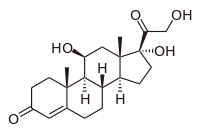
Photo from wikipedia
Pharmaceuticals, such as glucocorticoids and antibiotics, are inadequately removed from wastewater and may cause unwanted toxic effects in the receiving environment. This study aimed to identify contaminants of emerging concern… Click to show full abstract
Pharmaceuticals, such as glucocorticoids and antibiotics, are inadequately removed from wastewater and may cause unwanted toxic effects in the receiving environment. This study aimed to identify contaminants of emerging concern in wastewater effluent with antimicrobial or glucocorticoid activity by applying effect-directed analysis (EDA). Effluent samples from six wastewater treatment plants (WWTPs) in the Netherlands were collected and analyzed with unfractionated and fractionated bioassay testing. Per sample, 80 fractions were collected and in parallel high-resolution mass spectrometry (HRMS) data were recorded for suspect and nontarget screening. The antimicrobial activity of the effluents was determined with an antibiotics assay and ranged from 298 to 711 ng azithromycin equivalents·L-1. Macrolide antibiotics were identified in each effluent and found to significantly contribute to the antimicrobial activity of each sample. Agonistic glucocorticoid activity determined with the GR-CALUX assay ranged from 98.1 to 286 ng dexamethasone equivalents·L-1. Bioassay testing of several tentatively identified compounds to confirm their activity revealed inactivity in the assay or the incorrect identification of a feature. Effluent concentrations of glucocorticoid active compounds were estimated from the fractionated GR-CALUX bioassay response. Subsequently, the biological and chemical detection limits were compared and a sensitivity gap between the two monitoring approaches was identified. Overall, these results emphasize that combining sensitive effect-based testing with chemical analysis can more accurately reflect environmental exposure and risk than chemical analysis alone.
Journal Title: Environmental research
Year Published: 2023
Link to full text (if available)
Share on Social Media: Sign Up to like & get
recommendations!